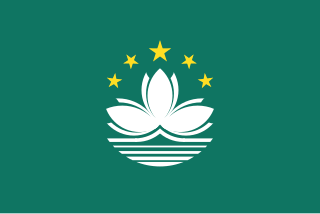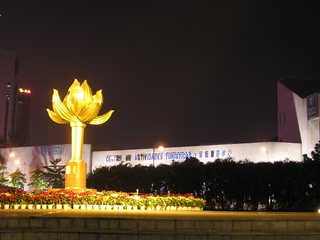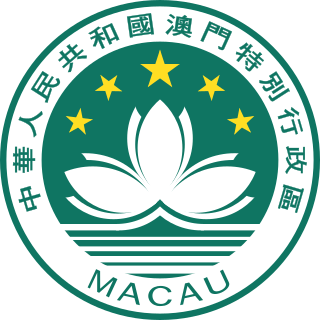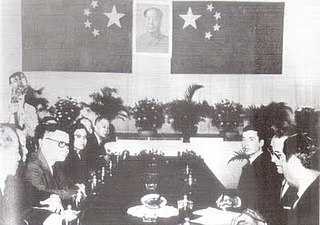
Macau or Macao is a special administrative region of the People's Republic of China. With a population of about 680,000 and an area of 32.9 km2 (12.7 sq mi), it is the most densely populated region in the world.
Politics of Macau is a framework of a politically constrained multi-party presidential system, dominated by the People's Republic of China. It includes the legislature, the judiciary, the government, and a multi-party system. Executive power is exercised by the government, led by the Chief Executive.

The national flag of Brazil, is a blue disc depicting a starry sky spanned by a curved band inscribed with the national motto "Ordem e Progresso", within a yellow rhombus, on a green field. It was officially adopted on 19 November 1889 — four days after the Proclamation of the Republic, to replace the flag of the Empire of Brazil. The concept was the work of Raimundo Teixeira Mendes, with the collaboration of Miguel Lemos, Manuel Pereira Reis and Décio Villares.

Taipa is an area in Macau, connected to Coloane through the area known as Cotai, which is largely built from reclaimed land. Located on the northern half of the island, Taipa’s population is mostly suburban. Administratively, the boundaries of the traditional civil parish Freguesia de Nossa Senhora do Carmo are mostly coterminous with that of the former Taipa Island, except for a portion of the parish that lies on the island of Hengqin (Montanha), housing the campus of the University of Macau.

The Macau Peninsula is the most populous and historical part of Macau. It has an area of 8.5 square kilometers (3.3 sq mi) and is geographically connected to Guangdong Province at the northeast through an isthmus 200 meters (660 ft) wide. The peninsula, together with downtown Zhuhai, sits on an island separated from the continent by distributaries of the Pearl River. The Border Gate was built on the northern isthmus. At the south, the peninsula is connected to Taipa Island by three bridges, the Friendship Bridge ; the Macau-Taipa Bridge ; and the Sai Van Bridge . The longest axis extends 4 kilometers (2.5 mi) from the Border Gate to the southwestern edge, Barra (媽閣嘴). There is a western "Inner Harbor" (內港) paralleled by an "Outer Harbor" (外港) to the east. The 93 meters (305 ft) Guia Hill (松山) is the highest point on the peninsula, which has an average elevation of 50 to 75 meters. Many coastal places are reclaimed from the sea. The Historic Centre of Macau, which is entirely on the Macau Peninsula, became a World Heritage Site in 2005.

The Regional Flag of the Hong Kong Special Administrative Region of the People's Republic of China depicts a white stylised five-petal Hong Kong orchid tree flower in the centre of a Chinese red field. Its original design was unveiled on 4 April 1990 at the Third Session of the Seventh National People's Congress. The current design was approved on 10 August 1996 at the Fourth Plenum of the Preparatory Committee of the Hong Kong Special Administrative Region. The precise use of the flag is regulated by laws passed by the 58th executive meeting of the State Council held in Beijing. The design of the flag is enshrined in Hong Kong's Basic Law, the territory's constitutional document, and regulations regarding the use, prohibition of use, desecration, and manufacture of the flag are stated in the Regional Flag and Regional Emblem Ordinance. The flag of Hong Kong was officially adopted and hoisted on 1 July 1997, during the handover ceremony marking the handover from the United Kingdom back to China.

The national flag of Cape Verde was adopted on 22 September 1992, replacing the flag adopted during Cape Verdean independence, fought for with Guinea-Bissau, another former Portuguese colony on mainland West Africa.

The Governor Nobre de Carvalho Bridge, also known as the Macau–Taipa Bridge, is a dual-lane two-way bridge connecting Macau Peninsula near Casino Lisboa and the island of Taipa at the northern slope of Taipa Pequena crossing the former Baía da Praia Grande. It is the first bridge in Macau, to connect the peninsula and Taipa. It is locally known as "The Old Bridge".

The Sai Van Bridge is a cable-stayed bridge located in Macau, it was inaugurated on December 19, 2004. The bridge measures 2.2 kilometers (1.4 mi) long and is the third one to cross the Praia Grande Bay connecting Taipa Island and Macau Peninsula on Hsiang-shan Island. It features a double-deck design, with an enclosed lower deck to be used in the event of strong typhoons when the other two bridges connecting Taipa and Macau Peninsula, both, single-deck, namely Ponte Governador Nobre de Carvalho and Ponte de Amizade, are closed. The lower deck of the bridge also carries the Macau Light Transit System, which started revenue operation almost nineteen years later on 8 December 2023.

The Lotus Square or Golden Lotus Square is an open square in Sé, Macau, China. The area features the large bronze sculpture Lotus Flower In Full Bloom and is somewhat akin to the Golden Bauhinia of neighbouring Hong Kong.

The Regional Emblem of the Macao Special Administrative Region of the People's Republic of China came into use on 20 December 1999, when the sovereignty of Macau was handed over from the Portuguese Republic to the People's Republic of China. The emblem is now referred to officially as the "Regional Emblem" (區徽).
The Macau Special Administrative Region, commonly known as Macau or Macao is one of the two special administrative regions (SARs) of the China (PRC), along with Hong Kong.

The handover of Macau from the Portuguese Republic to the People's Republic of China was at midnight on 20 December 1999. This event ended 442 years of Portuguese rule in the former settlement, which began in 1557.
Articles related to Macau include:

Macau Post and Telecommunications, most commonly known as CTT, is an entity under the Government of Macao responsible for postal services and telecommunications regulation.

The 12-3 incident was a series of political demonstrations and riots against Portuguese colonial rule in Macau which occurred on December 3, 1966. The incident, inspired by the Cultural Revolution in the People's Republic of China, occurred as a direct response to a violent police crackdown by colonial authorities against local Chinese protesters demonstrating against corruption and colonialism in Macau.

The following outline is provided as an overview of and topical guide to Macau:

The national flag of the People's Republic of China, also known as the Five-star Red Flag, is a Chinese red field with five golden stars charged at the canton. The design features one large star, with four smaller stars in an arc set off towards the fly. It has been the national flag of China since the foundation of the People's Republic of China on 1 October 1949. The flag was designed by Zeng Liansong.
José Manuel de Sousa e Faro Nobre de Carvalho was a Portuguese army brigadier-general and colonial administrator. He served as the 121st Governor of Macau from 1967 to 1974.












































